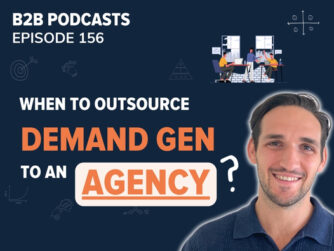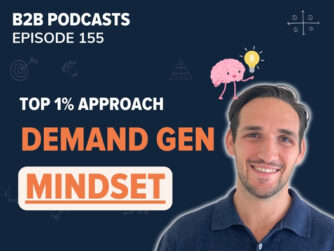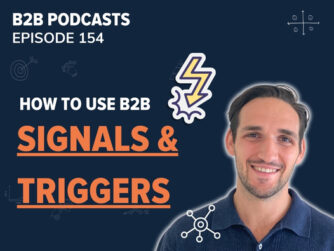When sales and marketing play on the same team, an organization is able to acquire new customers more efficiently. Research shows that aligned companies grow 19% faster and are 15% more profitable.
But the two are so often at odds with each other.
It’s a familiar story: Marketing are pressured to generate ‘leads’ right now. More often than not, this forces their hand to pass onto sales low-intent leads that have little brand awareness and interest in buying. On the other hand, sales are just looking for ‘hot deals’ to meet their quotas, and become disgruntled with marketing after their leads feel like a waste of time.
So how do we get sales and marketing back playing on the same team, to act as one revenue function?
To help you out, we’ve teamed with with Steve Armenti (VP Revenue Marketing and ex-Google) to discuss how the two roles can become more aligned, and start to work as one revenue team.
We put together a Sales and Marketing Workbook that you can grab for free below. It has 45 questions you can work through with sales and marketing to ensure you’re as aligned as possible. We’ve had amazing feedback from teams that used this workbook, so make sure you check it out!

This is part of our Demand Gen mini-series. You can access previous whiteboarding sessions here:
- What is demand generation? (part 1)
- When is the right time to start demand generation? (part 2)
- What companies are suited to demand generation? (part 3)
- How to build a winning business case for demand generation? (part 4)
- 10 questions to decide if you should build a new demand gen strategy (part 5)
- 5 steps to transition from lead gen to demand gen (part 6)
- Our B2B Demand Generation framework, The 5 BEs (part 7)
- Content That Generates Demand (part 8)
- Budgeting for Demand Gen – creation vs capture (part 9)
- Demand Generation KPIs (part 10)
- B2B Demand Generation Marketing Tech Stack (part 11)
- An introduction to Sales & Marketing Working Together (part 12)
As per usual, you can read, watch or listen below to work through our advice on how to align marketing and sales.
Listen To The Episode
This episode is sponsored by Factors.ai. Set your marketing and sales up for success with the tools and reporting you need. Click here to get 15% off with our special discount.
➡️Grab your Factors.ai 15% off discount here!

Watch The Episode
Step 1 – Sales and Marketing Must Understand Their Business Goals and Metrics
Objective: Gain a deep understanding of business goals, metrics, and challenges to identify areas for alignment and collaboration.
Every organization has limited time, resources and budget. If we want to maximize their impact, we have to work together on achieving common goals and impacting metrics together as a unit.
That’s why we recommend you explore the following questions between marketing and sales in this step:
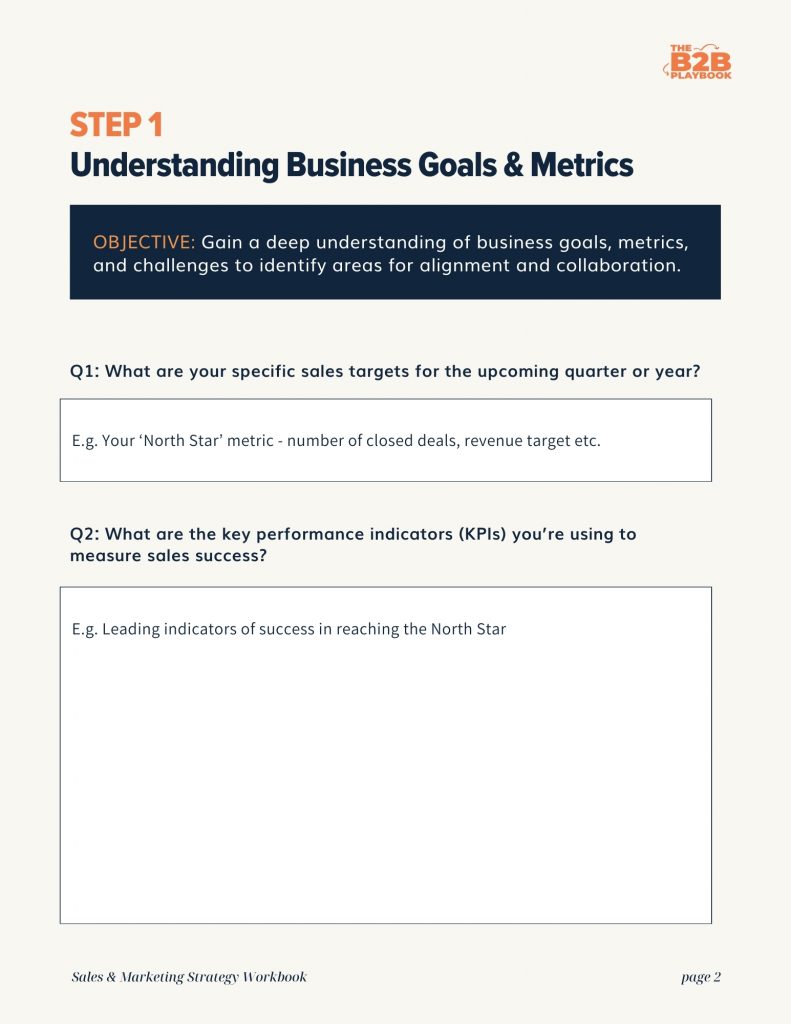
1.1 – What are your specific sales targets for the upcoming quarter or year?
This is your ‘north start’ metric that you and sales should be working together to meet. This may be a number of closed deals, a particular revenue target, or perhaps a pipeline target too. Discuss this with sales and leadership, and write it down.
1.2 – What are the KPIs you’re using to measure sales’ success?
We need to understand how sales and the business are tracking KPIs and leading indicators of success, so we’re confident we’re tracking on target to hit that north star metric. This might be a pipeline metric like the number of qualified opportunities. Note down what these are.
1.3 – What re the definitions of all targets and KPIs
Make sure you’re both aligned on the definitions of your targets and KPIs. When is a deal officially closed-won? How do we define qualified opportunities? What period of time do we measure these over?
1.4 – What do you expected to be contributed from marketing?
Is there an existing expectation from sales that marketing will contribute a certain percentage of pipeline or revenue? Will this be measured as marketing source or marketing influenced (see our guide here). Is this goal realistic?
Step 2 – Marketing and Sales Agree on ICPs
Objective: Develop a shared understanding of ideal customer profiles (ICPs) to ensure marketing efforts are targeted to attract the right buyers.
Very often, sales and marketing won’t have a shared understanding of who their Ideal Customers are – or if they do, it’s a very superficial one. If you’re going to market as one team, you need to agree on which segment you’re dedicating your resources to winning over.

2.1 – Who are your most profitable customer segments?
Start by running 80/20 analysis on your current set of customers to see which ones fit your business like a glove. Pick a time frame like the last 12 months, and start to understand what makes them such a great customer.
We find this is especially productive when sales, marketing and leadership are aligned on what makes a ‘best’ customer. The answer isn’t always revenue!
2.2 – What are the characteristics, pain points, and buying motivations of your ideal customers?
Both sales and marketing need to agree on what the key pains and problems are that you solve for. We highly suggest that you conduct customer interviews with your best customers to understand these.
You should understand:
- The top 3 pains your product solves for
- The benefits to the individual and company your product/service brings
- The key buying motivations for your best customers
- Why they chose you over the competition
2.3 – What are the key firmographics and technographics to identify your ICP?
The more we understand the firmographics and technographics of our ICP, the easier it will be for us to identify other companies that will also be a terrific fit for our product based on this information.
You’ll want to understand:
- ICP Firmographics (e.g. company size, revenue, industry, location)
- ICP Technographics (e.g. Hubspot, Mailchimp etc.)
- ICP Technology and Partners
2.4 – Who in marketing or sales will be responsible for the target account list?
If you’ve done the exercises properly up until now, you should be able to pull a list target accounts that you will attack as a team.
A key part of marketing and sales alignment is knowing whose job it is to do what. So make sure that marketing and sales are clear on who is responsible for the following:
- Where will the target account lists come from?
- Who is responsible for creating it?
- Who will scrub the list and prioritize it into segments for marketing campaigns?
2.5 – If there are multiple buyers in the ICP, how do we prioritize contacts?
As a general rule, the larger the organisation you’re selling to, the more people will be involved in the buying process. This is often referred to as a ‘buying committee’. You should identify each key person in the buying committee and what their impact on the decision is.
Once this is done, you need to decide which buying role you should prioritize in addressing with your sales and marketing efforts.
For example, this may look like:
- Tier 1 – Decision Maker – Director, CEO
- Tier 2 – Champion – CMO
- Tier 3 – Influencer – Marketing Manager
We try and work our way in with Tier 1, and if we’re unsuccessful, we reallocate our time and budget to Tier 2, and then Tier 3.
2.6 What are the reasons our ICP wouldn’t consider us?
You should also note down what makes companies a bad fit for your product or service, despite seemingly meeting the requirements set in your ICP. This is what we call ‘disqualification criteria’, and the closer you get to your customers, the more you’ll understand what makes someone a bad fit.
Try and distil this down to firmographic or technographic qualities so you can exclude these companies from your target lists.
Step 3 – Sales and Marketing Aligning Mapping the Customer Journey
Objective: Create a detailed map of the customer journey, identifying touchpoints and opportunities for collaboration between marketing and sales.
After interviewing your best customers, you should be able to piece together what a typical ‘customer journey’ looks like. This is unlikely to be a linear journey, but it’s important to map out the different information a prospect needs at each stage of awareness. Sales will also have some great insights here to help piece this together.

3.1 What are the different stages of the customer journey, from initial awareness to purchase?
At this stage you should list different stages of customer journey. Again, you should source this intel from customer interviews with your best customers, and insights from sales.
3.2 What specific marketing content or interactions are most effective at each stage of the customer journey?
You need to create content or audit your existing content to answer the questions that your prospects will have at each stage of the customer journey. Make sure you organise this content in an easy way for the sales team and marketing team to use and repurpose as necessary.
3.3 Who is in the buying committee?
It’s key to be aligned on who is typically in the buying committee for your target companies. You should also know when each member of the buying committee are involved at each stage of the customers’ purchasing process.
For example:
- Champion – often first point of contact in buying journey
- Influencer – enters deal at stage X
- Blocker – enters deal at stage X
- Decision Maker – enters deal at stage X
3.4 What are the key funnel metrics marketing can track to measure the impact of progressing prospects through the purchasing journey?
You should include key leading metrics to make sure your sales and marketing programs are starting to have their intended effects. You can see the metrics we recommend you track here.
Step 4 – Sales and Marketing Defining Lead Qualification Criteria
Objective: Establish clear lead qualification criteria to ensure marketing and sales have a shared understanding of what constitutes a high-quality lead.
One of the big breakdowns between marketing and sales is there isn’t a dictionary of shared definitions of clear lead qualification criteria. Without this, there’s no mutual understanding of exactly what constitutes a high-quality lead.

4.1 What defines a qualified lead?
Work through this by doing the follow exercise:
- Get marketing to write down their definition of a ‘qualified lead’
- Get sales to write down their definition of a ‘qualified lead’
- Then write down an agreed definition
4.2 What information do you need to evaluate lead quality?
It’s quite likely you’ll need some additional information to assess the quality of a lead. This may require some enrichment of your data to evaluate leads based on their firmographics.
You may also need other behavioural information to provide additional context, like what assets and pages on your website they’ve engaged with.
4.3 How can marketing prioritize, segment and route leads?
Based on the shared qualification criteria, marketing will need to prioritize, segment and route leads. This should be done in discussion with sales to make sure that the right leads are sent to the right people, with the right information to enable them to act.
4.4 How will sales give feedback to refine lead qualification criteria?
Refining lead qualification criteria (and disqualification criteria) is incredibly important. The faster sales is able to pass on what makes a company a good or a bad lead, the faster marketing is able to adjust its targeting and messaging accordingly.
Work out a system to create this feedback loop. This may be a combination of updating leads in a shared CRM, and weekly pipeline meetings with sales feedback where more qualitative data can be shared.
Step 5 – Sales and Marketing Aligning on Content Strategy
Objective: Develop a cohesive content marketing strategy that supports sales goals and provides valuable resources for potential customers.
Now marketing and sales have agreed on who their ideal customers are, and have a great idea as to what their buying journey looks like and what questions they have at each stage – we need to create content that answers those questions that both marketing and sales can use.

5.1 What topics and formats resonate best with our target audience?
The topics you choose to get in front of your target audience should help usher them through the buying journey, and position yourself as experts. We help you develop your content themes in our 12 week demand generation course, The B2B Incubator.
You should also present your content in a format that your audience are more likely to consume. For example, if you are selling and edtech solution to teachers who are busy reading and writing all day in the classroom, perhaps they may prefer to consume your content over a podcast or video.
5.2 What specific content themes can help sales engage with leads and move them through the buying journey?
The content you create should be mapped to the buying journey, so sales can easily identify where a prospect is in their journey and then offer valuable resources to answer their questions and help them progress to the next stage.
Again, our favourite way to map this out is to use the 5 Stages of Awareness framework.

5.3 How can marketing measure the impact of content on generating sales outcomes?
Marketing needs to verify that the content its creating is having a positive impact on your prospects, and progressing their buying journey. We recommend reviewing the leading and lagging indicators of success we discuss in depth here to get these metrics.
Step 6 – Establishing Joint Sales & Marketing Activities
Objective: Identify opportunities for joint sales and marketing activities to enhance lead generation and collaboration.
For prospects that are further down the funnel, sales and marketing need to work together to increase the chances of winning that deal as much as possible.

6.1 How will sales and marketing collaborate on events to target high value accounts?
Events are a great place to deepen relationships with high-value accounts. Sales and marketing will need to come up with a system to identify who these high-value accounts are that are worth targeting, and look for opportunities at the event to engage them in a deeper way.
Some ideas include:
- Inviting key members of the high-value account to join a round table
- Inviting key members of the high-value account to guest speak
- Inviting key members of the high-value account to be a guest on your podcast
6.2 How can marketing support sales during customer interactions like demos or presentations?
Sales may require certain collateral for their demos or presentations. This could include account and buyer specific information, like key pains – and surfacing relevant case studies to show you can achieve the outcome the customer wants.
6.3 How else does marketing need to support sales with collateral?
Other ways marketing may need to support sales includes:
- Collateral for specific sales driven campaigns
- Collateral for cross-sell or upsell opportunities
Step 7 – Implementing Sales Enablement Tools and Resources
Objective: Equip sales teams with the necessary tools, resources, and training to effectively engage with leads generated by marketing.
You should review as a team the different sales enablement tools and resources you have, and what else is required.
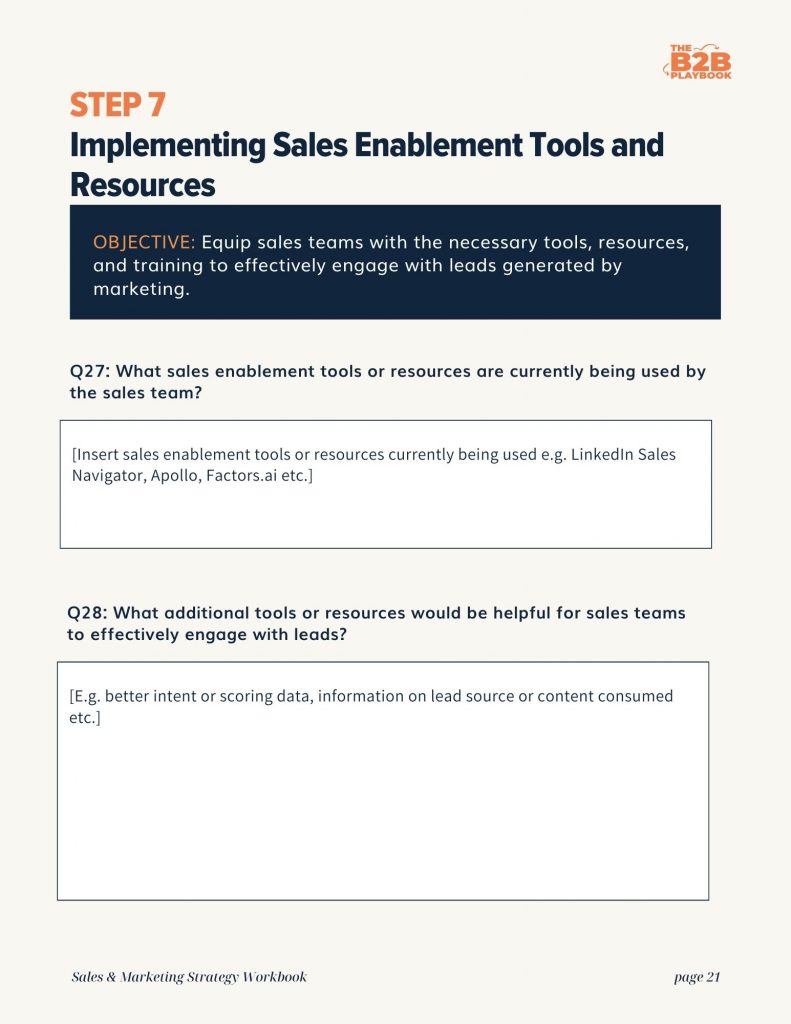
7.1 What tools or resources are required?
You should list what tools are currently in use, and what else is required to enable Sales to do their job.
For example, some great sales enablement tools include:
- LinkedIn Sales Navigator
- Apollo.io
- Factors.ai
Also ask yourself – what tools or resources would be helpful for sales teams to more effectively engage with leads?
For example, do they need better intent or scoring data? Or do they need more context on the lead to have a more productive conversation? In that case, information on lead source or what content they consumed could be important to surface easily for sales.
7.2 What case studies and customer stories do sales need?
Make sure you have relevant case studies and customer stories for sales. These should be specific to the segment that you’re targeting and aligned with the outcome you’re trying to help them achieve.
Ask sales what resources are missing from their perspective. Make sure these are all available in a content hub for them and are easily accessible.
Step 8 – Establishing Regular Communication and Feedback Loops between Marketing and Sales
Objective: Foster open communication and regular feedback exchanges between marketing and sales to ensure alignment and continuous improvement.
Feedback loops are so incredibly important for sales and marketing alignment. Sales are at the coalface, and are able to report back on what activities are/aren’t working. The stronger the feedback loop, the deeper you’ll understand your customers and their needs. And the more you understand them, the easier it will be for you to build relationships and win them over as customers.
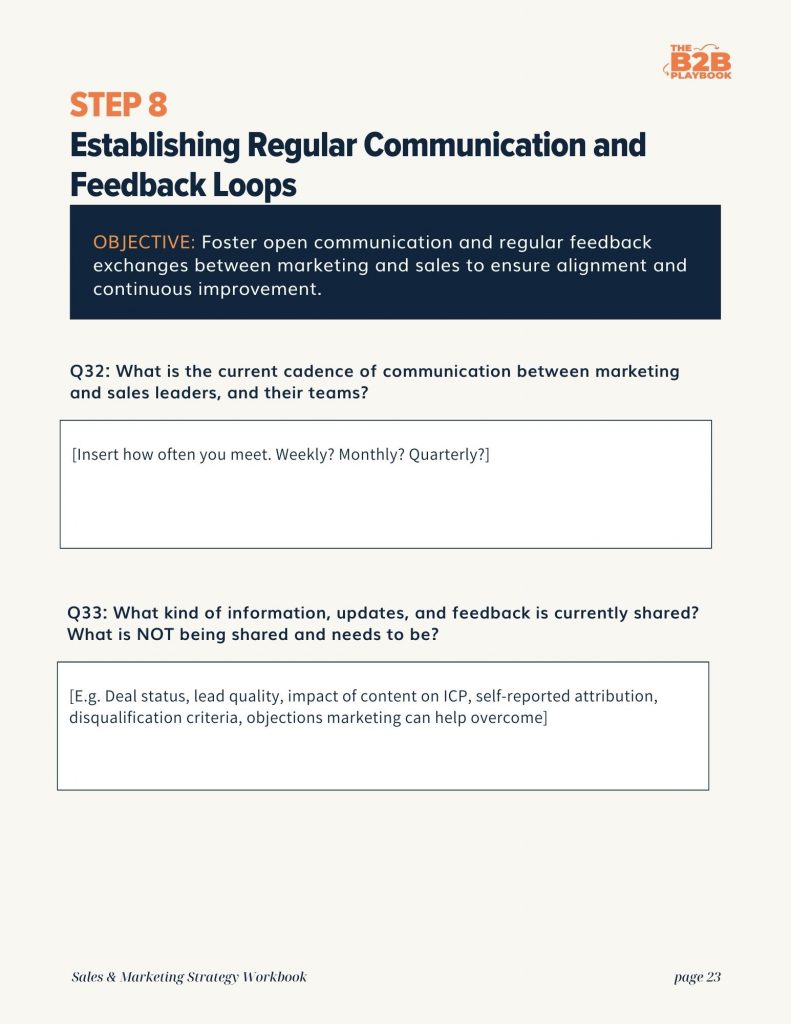
8.1 What is the current cadence of communication between marketing and sales leaders, and their teams?
You should note how often you currently meet with sales leaders and their teams. Is it weekly? Monthly? Quarterly?
Never?
This is our baseline to improve on.
8.2 What kind of information, updates, and feedback is currently shared between sales and marketing? What is NOT being shared and needs to be?
What quantitative and qualitative feedback is being shared between sales and marketing?
Are you discussing:
- Pipeline review
- Lead quality
- Impact of your content on your ICP
- Self-reported attribution
- Disqualification criteria
- Objections that come up to sales that marketing can help address
We recommend you create an agenda to go through each of these important items in a weekly quick stand-up with sales.
8.3 Do marketing and sales have documented, measurable SLAs?
An SLA is a service level agreement between marketing and sales that outlines and clarifies the responsibilities and goals of each department. This documents how the two teams will work together.
It also helps clarify where it isn’t clear which team handles certain actions. For example, the SLA may specify the information that marketing will provide around leads surfaced to sales, and the sales team agrees to specific follow-up guidelines for how they reach out to those leads.
This is also a great place to document all the agreed marketing, sales and shared KPIs.
Step 9 – Metrics and Measurement for Sales and Marketing Alignment
Objective: Establish shared KPIs and metrics to track the performance of marketing and sales efforts and measure the impact on revenue growth.
This step is very important for clarifying shared KPIs and reporting, so you can work together as one go-to-market team and drive revenue growth.
You should explore questions like:
- What sales metrics needs to be measured to prove success in the sales funnel?
- What marketing metrics need to be measured to prove success in the marketing funnel?
- What data sources will the teams use to track performance?
- What does the unified funnel look like and what metrics are presented to leadership?
- What dashboards or reports are needed to communicate insights and trends?

Step 10 – Continuous Improvement and Innovation
Objective: Foster a culture of continuous improvement and innovation in demand generation to adapt to market changes and drive sustainable revenue growth.
Marketing and sales alignment isn’t a ‘set and forget’. Your company will evolve, the market will change, your customer’s needs will change – so you need to have a process for continuously optimizing these feedback loops.
Make sure you regularly explore:
- What is the process to enable marketing and sales to ideate and test new strategies?
- How will the team react to emerging trends in the market and be more agile?
- How is real-time data and insights used to drive new ideation processes?
- What issues or organizational blockers exist today that prevent the two teams from innovating?

Grab Our Workbook and Start Working Better Together Today
We recommend marketing and sales work through these questions together over a few sessions. It’s an excellent way to bring the two teams together and start them working closer together – or to fill in any gaps for those teams that already have a good relationship.
You can grab the workbook the following ways:
- Get it here in PDF form (ungated)
- Download the Canva or PowerPoint template so you can edit it and make it your own (form below)!
A huge thanks to Steve Armenti and Factors.ai for collaborating with us on this one!





